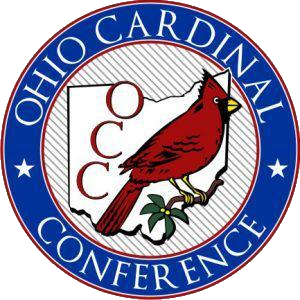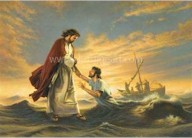| |
Dedication
Colossians 1: 16-17
For by him all things were created: things in heaven and on earth,
visible and invisible, whether thrones or powers or rulers or authorities:
all things were created by him and for him. He is before all things,
and in him all things hold together.
This painting of Jesus was created
by the English artist, Simon Dewey and is used with
permission.
Click
here to see more of his
work.
Introduction
When James A. Naismith of Springfield College (Mass.) used a peach basket and a soccer ball in 1891, his invention was called basket ball (two words). The chaplain/PE instructor only intended the activity for indoor exercise during the winter months. The A. G. Spalding Co. made first basket ball with laces in 1894. By the end of the decade the game was becoming a team spectator sport. However, selecting a venue with seating for the games was an arduous task in most communities.
Such was the case in Ashland at the turn of the Century. Only two sites were available for the games: the old West Main Street Armory at Town Creek and the 1903 College Gym with a dirt floor. Even when the new YMCA was built in 1909 they had so many members that the court was not available for a high school team. Thus AHS basketball had an inauspicious start with no coach, no home court, and little prestige in playing for the high school team.
Basketball was the third sport at Ashland High School. Track had the first Field Days beginning in 1896. Football had several years of what Paul “Spitz” Ganyard called a town team at the turn of the Century. In the school year of 1907 the Ashland High School Football and basketball teams were born. Thus it begs the obvious question, “why are the two sports celebrating their 100th season a year apart?”
AHS basketball never had their own home court until 1915. In the early years the cagers wandered between the old Armory, the College gym, and the YMCA. When the new high school on Cottage Street was built, it included what historically has been referred to as the Girls’ Gym. However, in the construction year of 1914-15 Ashland High School did not have a boys or a girls’ basketball team because of what the Yearbook referred to as for “various reasons.” It appears to be at least the same scenario: no home court and no coach.
Starting with the opening game in the old girls’ gym the Orange and Black began a rare tradition. After defeating Mansfield Dec. 18, 1915 each time the A’s moved to a new venue they won. From the East Main Armory to McDowell to Arrow Arena and even AC’s (Kates) gym every opening and dedication game resulted in an Ashland victory. The pattern was well documented in Betty Plank’s T-G column on Sat. February 10, 2007.
The winning saga continued during the regular seasons and the tournament trail, too. During the first 50-years the A’s had 34 seasons with double-digit wins, and for the first Century 64 ten-win seasons and 63 winning campaigns. As a member of four different leagues the Orange and Black captured 23 trophies (12 outright titles and 11 co-championships), plus adding 21 tournament crowns and advancing to the Sweet 16 six times. Their overall total of 44 titles ranks second in the 19-Ashland High School sports to golf, which has 52 firsts (22 league and 30 OHSAA championships).
Since letters were first awarded in 1915, a total of 480 players have won the Orange and Black chenille monogram. There are, also, another 27 cagers, who represented AHS mostly under the Red and White colors, before 1915. Throughout the span of the century only five players were four-year lettermen: Bob Howell, Dick Messner, Max Messner, Matt and Mark Hess. Taylor Housewright is on tract to earn his fourth letter during the 100th season, and Paul Ganyard, who was a starter on the first four AHS teams and before letters, deserves to be a genuine four-year letterman, too.
There are four players, who won first-team All-Ohio honors. They are: Earl Thomas, Dick Messner (twice), Bill Rogers (twice), and Ken Sidle. Three cagers were second-team All-Ohio, and they are: Ted Jacobs, Max Messner, and Tom Malone. The mantle of Ashland’s leading scorer has passed from Clarence' Dick Miller to Raymond Plank to Cresco “Nip” McHose to Ray Miller to Earl Thomas to Bob Sprague to Vince Barr to Ted Jacobs to Dick Messner to Bill Rogers to Ken Sidle to Max Messner to Steve Petee and to Chad Honaker.
There have been 22 head coaches throughout the Century of Arrow basketball with some distinguishing achievements. Cloyce Taylor had the most wins (157) and one of the best winning percentages (82.6%). Jim Barr coached the most games (11 years) and three CCC’s. Tony Lonero had the best winning percentage (85.4) plus taking two teams to State. Rosie Starn had three league titles and one team to the State. Harry Barnhart built the foundation for a winning tradition by developing the “Seconds” or what we know as JVs, plus he had three NCO crowns. A.L. Buckner, also, had three NCO titles and one team to the State. George Valentine had the highest scoring teams in AHS history. Sam Marchio was another coach with three league championships. Doug McDonald had the most championships (7) four-conference crowns and three Sectional titles. It was the Jody Peters team that won the 1000th game. Chris Stokes returned to the glory-days of years gone-by by taking two teams to the Regional tournament and winning the final OHC title.
The teams with the best records (20-2) are the Dick Messner-led 1947-48 cage unit and the Ken Sidle-led 1953-54 squad. The longest winning streak was 13 twice by the 1967-68 team and the start of the 1969-70 season, although Tony Lonero’s teams had 16 straight regular season wins over two years. That team led by Bob Sprague, also, won 18 straight North Central Ohio League games and made the Cleveland Plains sports page. The Arrows had six consecutive Cardinal Conference championships between 1967-73 and an 18-game CC string during that period. Also, in the midst of that era the A’s won 29-consecutive home games in Arrow Arena between 1967 and 1969. The 1932 team of Earl Thomas and the Red Lantern fame advanced to the Final Four, which was farthest that any AHS team made it on the OHSAA trail.
The register of AHS basketball players, who distinguished themselves with college careers, still grows. Nip McHose began the tradition by starring at Stanford. Earl Thomas, Ted Jacobs, and Ken Sidle played at Ohio State. Ashland College/University benefited with a long list of AHS cagers like: Dod Paxton in the 20’s; Bud Plank, Bob Sprague, Virg Scobey, Bus Hockensmith in the 30’s; Vince Barr, Don Debrus, and Dick Cooper in the 40’s; and the roll call continued with Jim Runyon, Randy Emmons, John Smith, and now Greg Emmons. Other stars re-wrote records like: Ray Miller at Wooster, Dick Messner at Wheaton, Bill Rogers at Bowling Green, and Dave Brubaker at Mount Union. This log hasn’t include the Query brothers at Wooster, Max Messner at Cincinnati (who played with the great Oscar Robertson), Mark Humrichouser at Capital, Dave Honaker at Alderson-Broaddus, Jason Hess at Malone, Matt Schlingman at Wooster, and Mark Hess at Mt. Vernon Nazarene.
Finally, this website needs a list of resources and credits. First is the renowned “green book” of Sid Boyd’s annals with scores and participants, which appears to be in collaboration with T-G sports editor Bill McKee’s records. One clarification needs to be inserted at this point. For most of the recorded history of AHS basketball 1909 was the initial season. However, the Yearbooks and the Ashland Press/Times-Gazette microfilms have team pictures and games beginning in the 1907-08 season. Thus someone will shortly surmise that the Lexington win wasn’t clearly the 1000th victory. True, but to the best of the Athletic Department’s knowledge and archives at that time, it was the 1000th win on record.
The bulk of this research comes from the AHS record book in the Athletic Department, the AHS Yearbooks beginning in 1908, the microfilms of the Ashland Times-Gazette available at the Ashland Public Library, and the game basketball programs which are still in the AHS file cabinets. Two additional publications, which this author researched and wrote, are: the 1992 “History of Ashland High School Arrow Basketball 1909-1992,” and the 2002 “Arrow Addendum: A 19 Sport History of Ashland High School.” Then there are the three league histories, which are in print and available on the Lincoln Highway Leagues website. Also, there is a degree of oral history where I personally interviewed people involved with AHS basketball and particularly Bud and Betty Plank, who share a passion for preserving the past.
For those with a gusto for AHS round ball there is a delightful reservoir of columns in the T-G microfilms at the Library. The memorabilia preserved on these reels is easily available and informative. They are found in: The Bullpen (Bill McKee), Scribbles by Tibbals (Loren Tibbals), The Village Smithey (Bob Smith), Here’s the Pitch (Bob Dixon), and others. Some recommended features are: Bob Lavengood’s six-part history of AHS sports (Oct 28, 1958-Feb 12, 1959), Keith Sanders series on Classic Ashland-Mansfield games (Jan. 1961), Chuck Mistovich (Sports Specs), and Sid Boyd’s Now and then articles in the late 60’s and early 70’s. The recent contributors, such as: Mike Dewey, Steve Eighinger, Larry Stine, and Dusty Sloan and his staff, have continued the Ashland B-ball chronicles.
Finally, the two people, who made this project a reality, are Cathy Buscher and Dave Honaker. Cathy is the talented Webmaster, who is the responsible for the Mansfield/Richland County Public Library website. This is her third website that the two of us have collaborated on. She has spent hundreds of hours on these three websites: The Lincoln Highway Leagues (NCO, Cardinal Conference, and Ohio Heartland Conference) in 2004, and last year The Century of Ashland Arrow Football (100th season), and now this 100th basketball season.
Dave is the entrepreneur, who raised the support for this project. The following individuals and businesses donated to the project: Sutton Bank (Jeff Honaker), Bendon Publishing (Chad Honaker), Western and Southern Financial Group (Dave Honaker), Lyn Way Restaurant (Rob Stoops), Ward Real Estate Coldwell Bankers (Rob Ward), Ingmand Insurance (Ryan Emmons), Ball Bounce and Sports (Jim Purtell), Mowry Construction and Engineering (Mike Mowry), Huntington Bank (Kip Matteson), (Dr. Dan Denbow) and Jim Patterson Eyecare, Buren Insurance Group, First Merit Bank, W G Masonary, Howard Honaker, and Jim Cutright. The individuals in parenthesis are AHS basketball alumni.
The 100th logo was picked by a committee of: AD. Rick Brindley, Dave Honaker, Dusty Sloan, David Housewright, George Valentine, Bud Plank, Rob Lavengood, and Paul Dienstberger. The final choice was a combination of entries from: Chris Kyser, Jordan Householder, Cathy Buscher, and Paul Dienstberger.
The Celebration Game will be on December 22, 2007. An Alumni game will be played at Arrow Arena beginning at 12 noon. The Celebration Game will be at AHS's Arrow Arena that evening, and a hospitality room will open at
5 PM. All former players and coaches will be recognized between the JV and Varsity game against Willard that evening. A signup for this day will be available on this website and at the AHS Athletic Office.
Now to 100 years of Arrows basketball. When the OPPONENTS are capitalized, it means an Ashland win. Otherwise in small case, it is an Ashland loss. The games with an asterick* are tournament games. The location of every season will be found by the winter side of the two years or the 2006-07 season will be found by clicking on 2006.
Questions or comments? Contact: Paul Dienstberger
|
|

